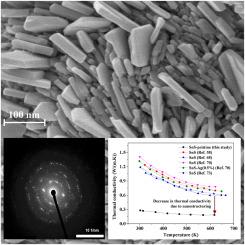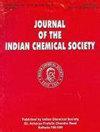Thermoelectric properties of polycrystalline pristine and Pb-doped SnS materials using a conventional hydrothermal method
IF 3.2
4区 化学
Q2 CHEMISTRY, MULTIDISCIPLINARY
引用次数: 0
Abstract
Tin Sulfide (SnS) has recently garnered significant attention due to its impressive Seebeck coefficient and low thermal conductivity. However, its electrical performance is notably poor, necessitating appropriate doping for its enhancement. To address this, we employed the conventional hydrothermal method to synthesize polycrystals of pristine and lead (Pb)-doped SnS samples to observe the impact on thermoelectric parameters. Utilizing FESEM, we obtained sheet sizes on the nanometer scale and observed irregular sheet-type morphology. HRTEM analysis confirmed the polycrystalline nature of the synthesized samples. Thermal stability assessment through thermogravimetric analysis (TGA) was conducted on all samples up to a temperature of 600 °C. The hydrothermal method resulted in nanostructuring that effectively suppressed the thermal conduction of low-frequency phonons, with increased phonon scattering attributed to the small grain size of particles. For pristine SnS nanoparticles, we determined the lowest total thermal conductivity (κT) to be 0.18 W (m-K)−1, and the highest Seebeck coefficient reached 412.71 μVK−1 at 620 K. In the case of the SnS–Pb(3 wt%) doped sample, there was a slight reduction in the total thermal conductivity (κT) compared to the pristine SnS sample. The pristine SnS sample exhibited the highest electrical conductivity (σ) of 0.21 S/cm at 620 K. In contrast, the SnS–Pb(3 wt%) doped sample demonstrated a twofold increase in electrical conductivity, measuring 0.38 S/cm at 620 K. This enhancement can be attributed to the increased carrier concentration resulting from the Pb(3 wt%) doping of SnS.

采用传统水热法研究原始多晶和掺杂铅的 SnS 材料的热电特性
硫化锡(SnS)因其出色的塞贝克系数和较低的热导率而在最近引起了广泛关注。然而,它的电气性能明显较差,因此需要适当掺杂以提高其性能。为此,我们采用传统的水热法合成了原始和掺铅 (Pb) SnS 样品的多晶体,以观察其对热电参数的影响。利用 FESEM,我们获得了纳米级的薄片尺寸,并观察到了不规则的片状形态。HRTEM 分析证实了合成样品的多晶性质。通过热重分析(TGA)对所有样品进行了热稳定性评估,最高温度为 600 ℃。水热法产生的纳米结构有效地抑制了低频声子的热传导,声子散射的增加归因于颗粒的粒度较小。对于原始 SnS 纳米颗粒,我们测定的最低总热导率(κT)为 0.18 W (m-K)-1,最高塞贝克系数在 620 K 时达到 412.71 μVK-1。相比之下,掺杂了 SnS-Pb(3 wt%) 的样品的导电率提高了两倍,在 620 K 时达到 0.38 S/cm。
本文章由计算机程序翻译,如有差异,请以英文原文为准。
求助全文
约1分钟内获得全文
求助全文
来源期刊
CiteScore
3.50
自引率
7.70%
发文量
492
审稿时长
3-8 weeks
期刊介绍:
The Journal of the Indian Chemical Society publishes original, fundamental, theorical, experimental research work of highest quality in all areas of chemistry, biochemistry, medicinal chemistry, electrochemistry, agrochemistry, chemical engineering and technology, food chemistry, environmental chemistry, etc.

 求助内容:
求助内容: 应助结果提醒方式:
应助结果提醒方式:


